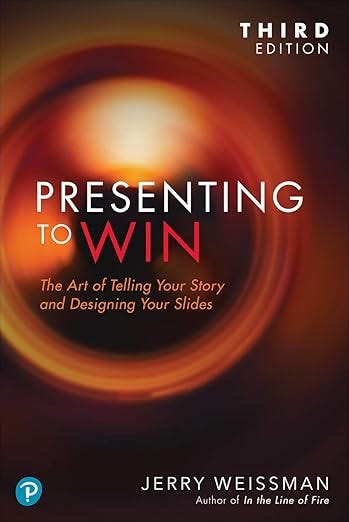In this fully updated edition of his classic Presenting to Win, the world's #1 presentation consultant helps you connect with even the toughest, most high-level audiences – and move them to action. Jerry Weissman shows in-person and online presenters of all kinds how to tell compelling stories that focus on exactly what's in it for their listeners.
Drawing on brand-new case studies, Weissman shows how to identify your key goals and messages before you even open your presentation software; stay focused on what your listeners really care about; and capture your audiences in the first crucial 90 seconds, even if you can't see them. From bullets and graphics to the effective, sparing use of special effects, Weissman covers all the practical mechanics of effective presentation.
This guide's easy, step-by-step approach has been proven with billions of dollars on the line, in hundreds of IPO road shows before the world's most jaded investors. They'll work for you, too!
Here are key lessons from Presenting to Win: The Art of Telling Your Story by Jerry Weissman:
Focus on the Audience: Your presentation should revolve around the needs, interests, and priorities of your audience, not on what you want to say. Always ask yourself, “What’s in it for them?”
Create a Clear and Compelling Storyline: Structure your presentation as a narrative with a clear beginning, middle, and end. Stories are engaging and help your audience remember your key points.
The Rule of Three: People tend to retain information better when it’s grouped into threes. Use this principle to organize your key messages and make your presentation more digestible.
Use Visuals Effectively: Slides are a visual aid, not the presentation itself. Avoid overwhelming your audience with text-heavy slides. Instead, use visuals to reinforce your message and keep the focus on you, the presenter.
Eliminate “The Information Overload”: Present only the most critical information. Too much data can confuse your audience and dilute your message. Stick to what supports your main argument.
Practice Makes Perfect: Rehearse your presentation multiple times. Familiarity with your content allows you to deliver confidently and focus on connecting with your audience.
Engage Emotionally: Appeal to the emotions of your audience by telling stories, using relatable examples, and delivering your message with passion. People are more likely to remember how you made them feel.
Anticipate Questions and Objections: Think about potential questions or challenges your audience may raise and prepare your responses in advance. This will help you handle objections smoothly and reinforce your credibility.
Open Strong, Close Stronger: Your opening should grab attention immediately, and your closing should leave a lasting impression. These are the most critical parts of your presentation.
Master Nonverbal Communication: Your body language, tone of voice, and eye contact matter as much as your words. Use them to convey confidence and connect with your audience.











